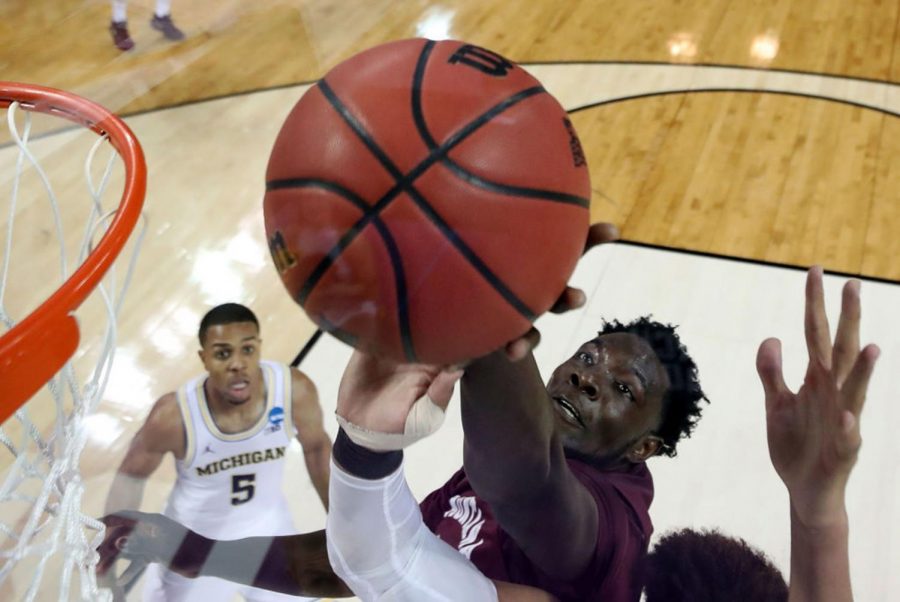In the War Room with Warfel: Lack of mid-major at-large bids shows culture of elitism
Jamar Akoh #15 of the Montana Grizzlies reaches for a rebound as Jaaron Simmons #5 of the Michigan Wolverines looks on during the first round of the NCAA Basketball Tournament at INTRUST Arena on March 15, 2018 in Wichita, Kansas.
March 21, 2019
As Selection Sunday rolls around each year, several mid-major fans are left wondering if their team will get an at-large bid into the big dance if they did not win their conference.
There is the option of the automatic bid for teams who win their conference tournament, as was the case for Bradley in the MVC, Murray State in the Ohio Valley Conference and Saint Louis in the Atlantic 10 conference.
The schools which received at-large bids outside of the “power five” conferences include Gonzaga, Belmont, Nevada, Temple and VCU representing mid-major universities.
Advertisement
It could be argued Temple is not a mid-major because it plays in the American Athletic conference; in college basketball, this is considered one of the better conferences.
Looking off of the NET, some mid-major teams on the outside looking in include Furman (41), Memphis (46), Lipscomb (49) and UNC Greensboro (60).
Arizona State (63) is one of three teams ranks lower than all four of the schools mentioned above, along with Minnesota (61) and St. John’s (73) as members of “power five” conferences received at-large bids.
While five teams from mid-major conferences getting at-large bids is good, it is down considerably since the 2006 season when the Salukis made the sweet 16.
In 2006, ten mid-major teams received at-large bids, including both Bradley and Northern Iowa from the Missouri Valley Conference.
That number has been cut in half in 13 years, which means teams from power five conferences tend to get bids over more deserving mid-major teams.
Many people look at schedules as an argument for why bigger schools get these bids, like they get them because they play a “stronger” schedule so are deemed as more “tournament worthy.”
Advertisement*
Looking at the schedules of those ten teams in 2006, Northern Iowa played schools like Iowa, Iowa State and LSU as part of their non-conference schedule.
Their 2019 counterpart, Bradley, played no teams in power five conferences, yet were still able to receive an at-large bid.
So if the argument is all about schedule, then why were the 2005-2006 Braves able to make the tournament with no games against teams from the “better” power five conferences?
When I first heard talk around selection Sunday where Indiana with a 17-15 record might get a bid or Texas with a 16-16 record might get in because they played “better” teams than a Belmont or a UNC Greensboro, I was frustrated to say the least.
I feel as if the mid-major teams across the country are under-appreciated in college basketball as a whole. Watch and don’t be surprised if Murray State makes a run to the sweet 16 or if it’s conference counterpart Belmont does as well.
People continue to say mid-majors have to schedule better teams in order to get at-large bids, but my question to those people is how?
I’ve heard many coaches from several mid-major schools describe how hard it is to schedule schools from the “dominant” conferences in college basketball.
What it comes down to, I believe, is these bigger college basketball programs are afraid to schedule these smaller schools because if they lose it takes away the possibility for them to be in the NCAA tournament.
This in turn creates a sense of “elitism” in my view, creating the idea the Big 10 conference is better because they have more bids than the Ohio Valley conference.
Looking at Michigan State’s schedule, who won the Big 10 tournament alone in their non-conference schedule, the best non-power five conference team they played going off of the NET ranking was Northern Illinois at 139.
Even looking to Duke, who received the number one overall seed, the best mid-major school they played was Yale at 86 who won their conference tournament.
So neither Duke or Michigan State, who were seeded one and two respectively in the east bracket, played a Furman or a Memphis or a UNC Greensboro.
While some people may say mid-majors need to schedule better, my question to you is how? When this culture of elitism prevails it gets harder for schools of lower stature to become relevant.
This is why I urge fans to root for the Loyola’s who make the final four runs, root for the UMBC’s who upset the number one team.
When this happens, it does show the unpredictability of college basketball, yes, but I believe it also helps to counter the idea one team is “better” than another.
Sports editor Adam Warfel can be reached at [email protected] and on Twitter at @Warfel_Adam.
To stay up to date with all your Southern Illinois news, follow the Daily Egyptian on Facebook and Twitter.
Advertisement









